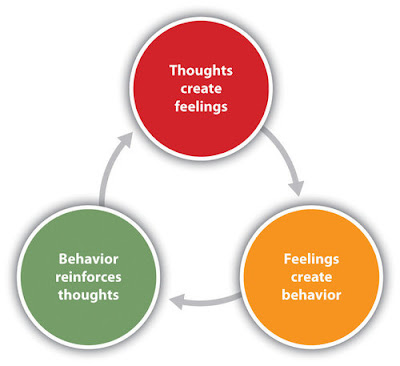If you've been following this blog for more than a few months you may recall some of my earlier postings where I compared Design Thinking to core concepts in other areas like Bloom's Taxonomy in teaching and Adizes' model of management theory. Today we're going out on the limb again, but this time in the realm of psychology, to compare DT with Cognitive Behavioral Therapy (CBT). This was prompted by my recent discovery of a graphic used to describe CBT, The Thinking - Feeling - Behavior triangle;
In layman's terms, cognitive behavioral therapy helps you learn to change your thoughts, feelings and behaviors so you feel better. By targeting your responses to situations, CBT can help you react more effectively in challenging situations, and even learn to feel better when you are unable to change situations happening around you.
 |
| Three areas of interest |
Comparing these two; business is behavior, technology is the thinking and people are the feelings.
Although I had seen both of these before, I hadn't noticed the parallels between the three part (Feelings, Thoughts and Actions) brain model and the Feel - Think - Do/Build and Empathy - Technology - Busi-ness triads of Design Thinking or the meta-level Design is a process of Learning framework. Of course, now that I see it, it seems obvious.
Another obvious parallel is that in CBT human needs are the focus of the process.


Feelings, thoughts and actions are interconnected when it comes to deal with the CBT. You are right in your blog that there must be design thinking that will actually impact your different sort of thinking patterns in daily life. Therefore, try to make your thinking in a designed way.
ReplyDeleteI have found that this site is very informative, interesting and very well written. keep up the nice high quality writing. Cbt Therapy Slough
ReplyDeleteA very useful information with understandable language. Really appreciate your writing skills. behavior analysis support services
ReplyDeleteThank you for sharing this valuable information. If you are searching for the best therapist who provides quality CBT therapy in New York, I highly recommend visiting Dr. Lisa.
ReplyDeleteThank you for sharing this blog with such valuable information. It has been incredibly helpful to me. If you are currently seeking therapy for emotional regulation, I highly recommend connecting with CBT DBT Associates.
ReplyDeleteThis comment has been removed by the author.
ReplyDeleteA behavioral therapist in Hyderabadis a professional specializing in the assessment, diagnosis, and treatment of various behavioral and mental health disorders using evidence-based therapeutic interventions. They work with individuals of all ages, from children to adults, helping them overcome challenges related to behavioral issues, emotional regulation, social skills, and mental health conditions.
ReplyDeleteFinding a behavioral therapist in Hyderabad can provide valuable support for individuals seeking help with various psychological and emotional challenges. Behavioral therapists utilize evidence-based techniques to address issues such as anxiety, depression, stress, and behavioral disorders. Whether it's cognitive-behavioral therapy, dialectical behavior therapy, or other therapeutic approaches, working with a skilled behavioral therapist can empower individuals to develop coping strategies, improve self-awareness, and foster positive changes in their lives. It's essential to research and connect with licensed and experienced therapists in Hyderabad who can provide personalized and effective treatment tailored to individual needs.
ReplyDeleteIt's fascinating to see the connection between Design Thinking and Cognitive Behavioral Therapy (CBT). Both approaches encourage individuals to break down complex problems into manageable parts, whether in creative processes or behaviour support and therapy. The Thinking-Feeling-Behaviour triangle in CBT, much like Design Thinking, promotes a structured yet flexible way to address emotional and behavioural challenges. This comparison really highlights how different disciplines can intersect to help people rethink and reshape their behaviour.
ReplyDelete